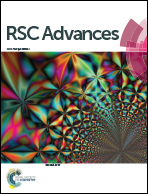Exploring indium tin oxide capped titanium dioxide nanolace arrays for plasmonic photocatalysis
Abstract
We report a convenient nanotechnique to fabricate indium tin oxide (ITO) capped titanium dioxide (TiO2) nanolace arrays for plasmonic photocatalysis. The topography can be tuned to optimize the photocatalytic efficiencies by adjusting the anodic voltage or the time of ITO magnetron sputtering. Microstructural analysis and finite difference time domain simulations indicate the generation of ITO surface plasmon resonance in the near-infrared region and ITO–TiO2 heterojunctions. The enhanced photocatalytic performance of such ITO–TiO2 composite nanostructures could spur further interest in the utilization of the near-infrared region for plasmonic photocatalysis.


 Please wait while we load your content...
Please wait while we load your content...